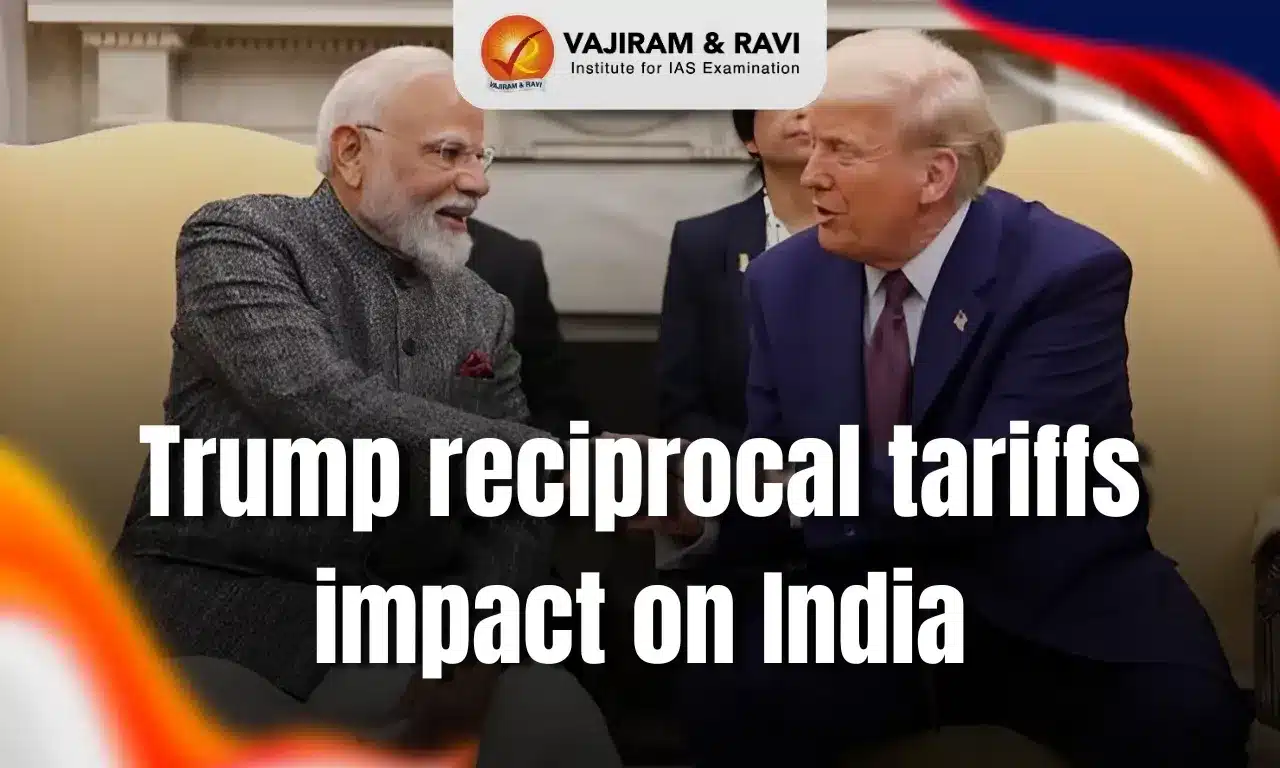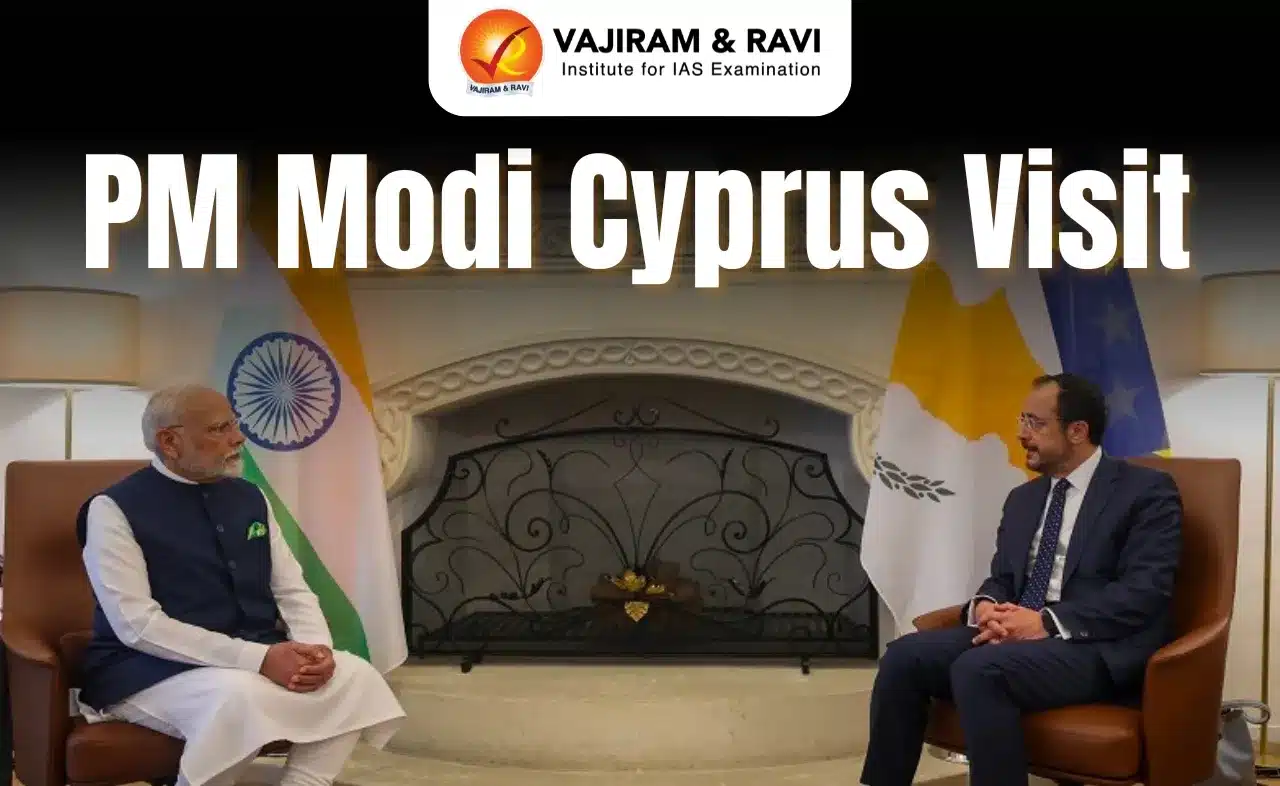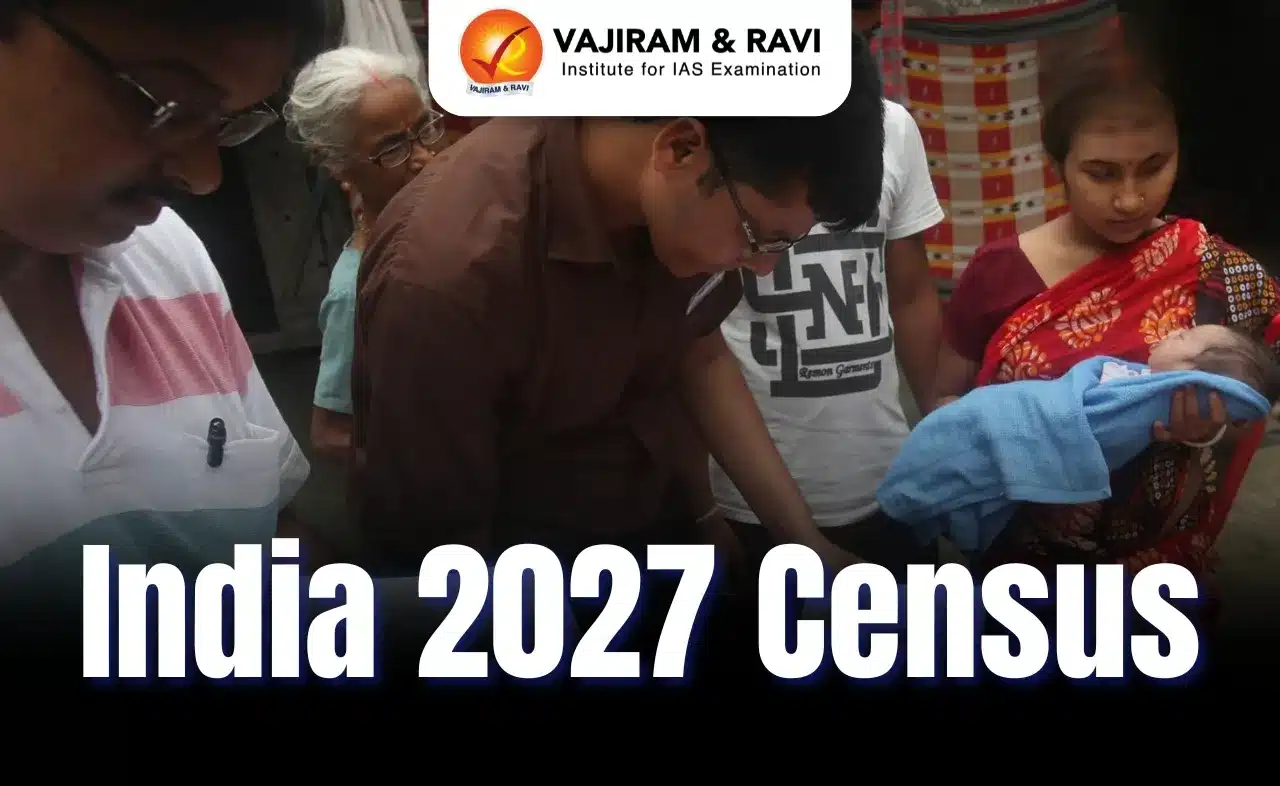What’s in Today’s Article?
- Trump reciprocal tariffs impact on India Latest News
- Reciprocal Tariffs
- Calculation of Reciprocal Tariffs
- Trump Imposing Reciprocal Tariffs – Reasons
- Reciprocal tariffs – Impact on India
- Trump reciprocal tariffs impact on India FAQs
Trump Reciprocal Tariffs impact on India Latest News
- Recently, US President Donald Trump announced plans to impose “reciprocal tariffs” on all countries, with implementation expected after April 1st.
- This move could roll back global trade by nearly a century, disregarding existing World Trade Organization agreements. By targeting both allies and adversaries, Trump signals a shift away from established trade norms.
Reciprocal Tariffs
- Tariffs are taxes imposed by an importing country on foreign goods, making them more expensive for domestic consumers.
- For example, if a US citizen orders a Banarasi saree from India, US import tariffs will increase its price, affecting affordability.
- Higher tariffs slow down global trade by raising costs for all parties involved.
The Move Towards Free Trade
- Since World War II, the global economy has shifted toward freer trade, as developed nations agreed that open markets benefit all.
- Agreements like GATT and WTO ensured that developing nations received special and differential treatment to protect their industries from stronger economies.
- This allowed countries like India to maintain higher tariffs to safeguard local farmers and manufacturers from competition with highly industrialized nations.
Trump’s Shift to Reciprocal Tariffs
- Trump’s “reciprocal tariffs” policy seeks to eliminate preferential treatment for any country.
- Under this system, the US will impose the same level of tariffs on imports as other nations impose on US exports.
- Trump argues this approach is “fair” and removes the need for complex trade agreements, disregarding historical trade arrangements designed to protect developing economies.
Calculation of Reciprocal Tariffs
- The exact calculation method for reciprocal tariffs is still being finalized, with the US trade department expected to determine the final rates for each country by April.
Beyond Simple Tariff Matching
- Instead of just mirroring tariff rates, the US plans to consider various subsidies and financial assistance provided by other countries to their exporters.
- This means that if a country like India offers subsidies to its industries, the US may factor those into its tariff calculations to create a “level playing field.”
Impact on Developing Countries
- If this approach is strictly implemented, developing nations like India, which heavily subsidize exports, will face higher tariffs on their goods in the US market.
- For instance, between 2022 and 2024, India provided $1 billion (₹8,700 crore) in subsidies under the Production Linked Incentive (PLI) scheme to boost handset exports.
- Since the PLI scheme is essentially a subsidy, it could lead to higher US tariffs on Indian goods.
Trump Imposing Reciprocal Tariffs – Reasons
- Trump’s decision is driven by multiple factors, not just targeting a single country.
- While China is the US’s biggest competitor, his initial tariff threats were aimed at close allies like Canada and Mexico.
Targeting Allies and Trade Partners
- Trump has criticized the European Union (EU) for unfair trade practices against US companies and linked tariffs on Canada and Mexico to broader concerns like illegal immigration and drug exports into the US.
Trump’s Obsession with Trade Deficits
- The primary motivation behind Trump’s tariffs is his strong opposition to trade deficits—the gap between imports and exports.
- The US trade deficit is nearing $1 trillion, while China enjoys a surplus of over $1 trillion.
- Trump views trade deficits as evidence that the world is cheating the US by not playing fair.
How Trump Plans to Eliminate Trade Deficits
- Forcing Other Countries to Import More US Goods – Encouraging nations to buy American products to balance trade.
- Compelling Companies to Set Up Manufacturing in the US – Making it costlier for foreign companies to export to the US, pushing them to establish production units within the country.
Reciprocal tariffs – Impact on India
- Given India’s historically high tariffs on US goods, it is expected to be among the nations most affected by Trump’s decision.
- Bilateral trade (April–Nov 2024): $82.52 billion
- India’s exports to the US: $52.89 billion
- India’s imports from the US: $29.63 billion
- Trade surplus in India’s favour: $23.26 billion
Sectors at Risk
- US tariffs could impact key Indian exports, including food products, textiles, clothing, electrical machinery, gems & jewellery, pharmaceuticals, and automobiles.
Increased US Imports
- To balance trade, India may import more US goods, including defence equipment, oil, and consumer products. This could lead to a reduction in India’s trade deficit with the US.
Rupee Depreciation
- Higher imports from the US would increase demand for dollars, leading to a weaker Indian rupee against the US dollar.
Impact on Domestic Consumption & GDP Growth
- The recent Rs 1 lakh crore tax break in India aimed at boosting consumption may lead wealthy Indians to spend more on US goods, rather than on Indian products.
- This could limit the expected boost to India’s GDP, as more money flows into the US economy instead.
Long-Term Benefits & Risks
- Cheaper US goods could benefit Indian consumers.
- Stronger trade ties with the US could help India’s economic growth and global positioning.
- However, this might undermine Atmanirbhar Bharat, as more US imports reduce demand for Indian-made products.
Trump reciprocal tariffs impact on India FAQs
Q1. Which is an example of a tariff?
Ans. A tax imposed by the US on Indian textiles, making them costlier for American buyers, is an example of a tariff.
Q2. What is the reciprocal tariff?
Ans. A policy where the US imposes the same tariff rate on imports as other countries impose on US exports.
Q3. When was the WTO established?
Ans. The World Trade Organization (WTO) was established on January 1, 1995, replacing the General Agreement on Tariffs and Trade (GATT).
Q4. What is WTO and its functions?
Ans. The WTO regulates global trade, resolves disputes, enforces trade agreements, promotes fair competition, and facilitates trade negotiations among nations.
Q5. Why is GATT replaced by WTO?
Ans. The WTO replaced GATT to provide a formal global trade framework, stronger dispute resolution, and enforceable trade agreements among nations.
Last updated on June, 2025
→ UPSC Notification 2025 was released on 22nd January 2025.
→ UPSC Prelims Result 2025 is out now for the CSE held on 25 May 2025.
→ UPSC Prelims Question Paper 2025 and Unofficial Prelims Answer Key 2025 are available now.
→ UPSC Calendar 2026 is released on 15th May, 2025.
→ The UPSC Vacancy 2025 were released 1129, out of which 979 were for UPSC CSE and remaining 150 are for UPSC IFoS.
→ UPSC Mains 2025 will be conducted on 22nd August 2025.
→ UPSC Prelims 2026 will be conducted on 24th May, 2026 & UPSC Mains 2026 will be conducted on 21st August 2026.
→ The UPSC Selection Process is of 3 stages-Prelims, Mains and Interview.
→ UPSC Result 2024 is released with latest UPSC Marksheet 2024. Check Now!
→ UPSC Toppers List 2024 is released now. Shakti Dubey is UPSC AIR 1 2024 Topper.
→ Also check Best IAS Coaching in Delhi
























